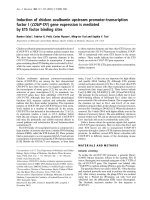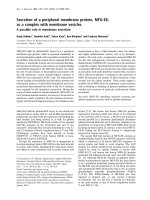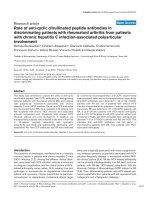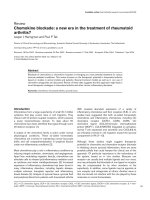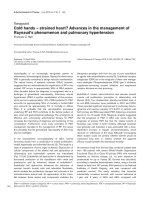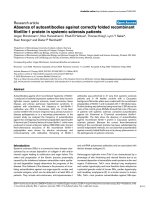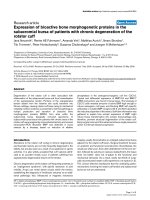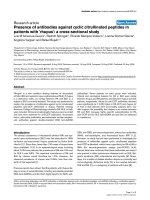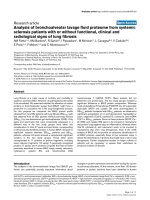Báo cáo y học: "Influence of HLA DRB1 alleles in the susceptibility of rheumatoid arthritis and the regulation of antibodies against citrullinated proteins and rheumatoid factor" ppsx
Bạn đang xem bản rút gọn của tài liệu. Xem và tải ngay bản đầy đủ của tài liệu tại đây (697.55 KB, 8 trang )
Balsa et al. Arthritis Research & Therapy 2010, 12:R62
/>Open Access
RESEARCH ARTICLE
BioMed Central
© 2010 Balsa et al.; licensee BioMed Central Ltd. This is an open access article distributed under the terms of the Creative Commons
Attribution License ( which permits unrestricted use, distribution, and reproduction in
any medium, provided the original work is properly cited.
Research article
Influence of HLA DRB1 alleles in the susceptibility
of rheumatoid arthritis and the regulation of
antibodies against citrullinated proteins and
rheumatoid factor
Alejandro Balsa*
1
, Arancha Cabezón
2
, Gisela Orozco
3
, Tatiana Cobo
1
, Eugenia Miranda-Carus
1
, Miguel Ángel López-
Nevot
4
, José Luis Vicario
5
, Emilio Martín-Mola
1
, Javier Martín
3
and Dora Pascual-Salcedo
2
Abstract
Introduction: The purpose of this study was to investigate the association between HLA-DRB1 alleles with
susceptibility to rheumatoid arthritis (RA) and production of antibodies against citrullinated proteins (ACPA) and
rheumatoid factor (RF).
Methods: We studied 408 patients (235 with RA, 173 non-RA) and 269 controls. ACPA, RF and HLA-DR typing were
determined.
Results: We found an increased frequency of HLA DRB1 alleles with the shared epitope (SE) in ACPA-positive RA.
Inversely, HLA DRB1 alleles encoding DERAA sequences were more frequent in controls than in ACPA-positive RA, and a
similar trend was found for HLA DR3. However, these results could not be confirmed after stratification for the presence
of the SE, probably due to the relatively low number of patients. These data may suggest that the presence of these
alleles may confer a protective role for ACPA-positive RA. In RA patients we observed association between SE alleles
and ACPA titers in a dose-dependent effect. The presence of HLA DR3 or DERAA-encoding alleles was associated with
markedly reduced ACPA levels. No association between RF titers and HLA DR3 or DERAA-encoding alleles was found.
Conclusions: HLA DRB1 alleles with the SE are associated with production of ACPA. DERAA-encoding HLA-DR alleles
and HLA DR3 may be protective for ACPA-positive RA.
Introduction
Rheumatoid arthritis (RA) is a complex autoimmune dis-
ease that develops from the combined effects of genetic
and environmental factors. It is estimated that the herita-
bility of RA accounts for about 50% to 60%, and the most
important genetic risk factors are the HLA class II mole-
cules, which contribute to one third of the total genetic
susceptibility [1,2]. There is extensive evidence for the
association between certain HLA-DRB1 alleles with a
conserved amino acid sequence (Q/RK/RRAA) at resi-
dues 70 to 74 in the third hypervariable region of the
DRβ1 chain, the so-called shared epitope (SE), and sus-
ceptibility to and severity of RA [3,4].
Autoimmunity in RA is characterized by the presence
of autoantibodies. Rheumatoid factor (RF) is not specific
to RA as it may be present in other diseases and in
healthy older individuals [5]. In contrast, anti-citrulli-
nated protein antibodies (ACPAs) seem to play a pivotal
role in the pathogenesis of RA as they are highly specific
[6], can be detected years before the onset of symptoms
[7,8], may predict progression to RA in patients with
undifferentiated arthritis [9,10], are associated with the
extent of joint destruction [11], and enhance disease
severity in animal models of arthritis [12].
Recent studies, including our data, have demonstrated
that SE alleles are associated only with ACPA-positive RA
[13,14] and more strongly with ACPAs than with RA
* Correspondence:
1
Servicio de Reumatología, Hospital Universitario La Paz, Paseo de la
Castellana, 261, Madrid, 28046, Spain
Full list of author information is available at the end of the article
Balsa et al. Arthritis Research & Therapy 2010, 12:R62
/>Page 2 of 8
itself [15], suggesting that SE alleles may influence anti-
gen presentation pathways leading to ACPA production;
SE alleles have been used to subdivide patients into dis-
tinct immunopathogenetic disease classes [4]. Whereas
the association between ACPA-positive RA and SE-con-
taining HLA class II molecules is well established, the
association between HLA-DR protective versus non-pre-
disposing alleles and ACPA-negative RA is controversial.
Certain HLA-DR alleles may reduce the risk of develop-
ing RA and have been termed 'protective alleles'; how-
ever, the definition of 'protective alleles' differs depending
on the study [16], making all of these results difficult to
interpret. Alleles with the DERAA motif at positions 70
to 74 in the third hypervariable region have been associ-
ated with a reduced risk of RA susceptibility [17,18] and
less severe disease [17,19,20], whereas other studies have
found conflicting results regarding HLA-DR3 [21-24].
Reproducing genetic associations is very important,
and studies performed in cohorts outside of North Amer-
ica or Northwest Europe are especially welcome due to
differences in allele frequencies and genetic background.
To better understand the effect of HLA in RA in the
Spanish population, we investigated the association of
SE-containing HLA-DRB1 alleles with susceptibility to
RA and then examined the possible protective effect of
HLA-DR3 and DERAA-encoding alleles. Finally, the
effects of these alleles on the magnitudes of RF and ACPA
production were determined.
Materials and methods
We studied 408 patients referred to the early arthritis
clinic of La Paz University Hospital, Madrid. Data from
this cohort have been previously reported [14]. At enroll-
ment or during follow-up, 235 patients fulfilled the 1987
American College of Rheumatology criteria for RA and
173 were diagnosed with non-RA (mainly undifferenti-
ated arthritis, psoriatic arthritis, reactive arthritis, and
other connective tissue diseases) (Table 1). Most of the
patients (91%) in the two groups have been followed up
with for more than 1 year (mean follow-up of 6.5 years).
We included 269 healthy volunteers as controls. The
study was approved by the La Paz University Hospital
ethics committee, and all subjects were of Spanish origin
and provided written informed consent.
For every patient, laboratory tests were performed on
blood samples that were obtained during the patient's
first visit to the clinic (before treatment with disease-
modifying antirheumatic drugs) and that were stored at -
40°C. RF was measured by nephelometry (Behring Neph-
elometer Analyzer II; Dade Behring, Inc., Deerfield, IL,
USA) with a detection limit of 15 U/mL, and ACPAs were
determined by a second-generation anti-CCP-2 antibody
enzyme-linked immunosorbent assay (ELISA)
(Immunoscan RA Mark 2; Euro-Diagnostica, Arhem, The
Netherlands) with a cutoff level of 25 arbitrary units per
milliliter in accordance with the instructions of the man-
ufacturer. The range of measurement was 0 to 1,600 U/
mL, and all values higher than this upper limit were trun-
cated and considered to be 1,600 U/mL for the analysis.
In DNA samples obtained from peripheral blood of
controls and cases, HLA class II alleles were genotyped
using a reverse dot-blot kit with sequence-specific oligo-
nucleotide (SSO) probes (Dynal RELITM SSO HLA-
DRB1 typing kit; Dynal Biotech, Bromborough, UK).
When necessary, high-resolution typing of HLA-
DRB1*03 samples was performed using Dynal AllSetTM
SSP DRB1*03. The following alleles were considered SE-
positive: DRB1*0101, *0102, *0401, *0404, *0405, *0408,
*0410, *1001, and *1402. DERAA-encoding alleles were
HLA-DRB1*0103, *0402, *1102, *1103, *1301, *1302, and
*1304.
Statistical analysis was performed using the Statistical
Package for the Social Sciences, version 10.0 (SPSS Inc.,
Chicago, IL, USA). Odds ratios (ORs) and proportions
were compared by the chi-square test. Differences in val-
ues between groups were analyzed using Kruskal-Wallis
and Mann-Whitney U tests for non-parametric data.
Results
Of the 253 patients with RA, 143 (61.9%) had ACPAs and
169 (72.5%) RF (Table 1). The presence of both autoanti-
bodies was strongly associated with RA (OR 27.4, 95%
Table 1: Baseline characteristics of the patients in the study
RA (n = 253) Non-RA (n = 173)
Age in years, mean ± standard deviation 62 ± 12 50 ± 14
Percentage of patients who are women 64 55
ACPA-positive, number (percentage) 143 (61.9%) 9 (5.6%)
RF-positive, number (percentage) 169 (72.5%) 27 (15.9%)
Duration of symptoms in weeks, median
(range)
20 (3-52) 15 (2-52)
Percentages exclude missing data.
ACPA, anti-citrullinated protein antibody; Non-RA, other arthropathies; RA, rheumatoid arthritis; RF, IgM rheumatoid factor.
Balsa et al. Arthritis Research & Therapy 2010, 12:R62
/>Page 3 of 8
confidence interval [CI] 14.08 to 53.34, P < 0.001 and OR
14.99, 95% CI 9.18 to 24.45, P < 0.001, respectively). In
non-RA patients, only 9 (5.6%) and 27 (15.9%) had
ACPAs and RF, respectively (Table 1). Double-positivity
for both ACPAs and RF was found in 137 (59.3%) patients
with RA and in 6 (3.5%) patients with other arthropa-
thies.
The distribution of our study population with respect
to HLA-DRB1 genotypes and alleles is shown in Tables 2
and 3. As described previously, an increased frequency of
HLA-DRB1 alleles encoding the SE was found in patients
with RA compared with non-RA and control subjects
(56.2% versus 35.5%, OR 2.33, 95% CI 1.56 to 3.5, P <
0.001 and 56.2% versus 41.6%, OR 1.8, 95% CI 1.26 to
2.56, P = 0.001, respectively). There was a dose-depen-
dent effect of SE-encoding HLA-DRB1 alleles: 29.8% of
RA cases and 24.9% of controls had one allele (OR 1.89,
95% CI 1.13 to 3.13), whereas 14% of RA cases and 5.6%
of controls were homozygous for SE-encoding HLA-
DRB1 alleles (OR 3.97, 95% CI 1.93 to 8.16) (Table 3).
The frequency of HLA-DR3 alleles was lower in the RA
group than in the non-RA group (18.3% versus 28.3%, OR
0.57, 95% CI 0.36 to 0.90, P = 0.012) but was similar to
that of the healthy controls (18.3% and 19.7%, respec-
tively). No differences in the DERAA-encoding allele dis-
tribution were found among the three groups (RA 23.4%,
non-RA 26.6%, and controls 26.8%, P = 0.39). Next, we
studied the effect of the presence of HLA-DR3 or
DERAA-encoding alleles in combination with the SE on
susceptibility to RA. In the presence of one SE allele, an
HLA-DR3 or DERAA-encoding allele reduced the risk of
developing RA, although the effect was not statically sig-
nificant (OR 1.11, 95% CI 0.51 to 2.43 for HLA-DR3 and
OR 1.04, 95% CI 0.46 to 2.36 for DERAA-encoding
alleles) (Table 3). Finally, to study the effect of the pres-
ence of HLA-DR3 or DERAA-encoding alleles on suscep-
tibility, we combined homozygous and heterozygous
patients and controls for these alleles and compared them
with 'neutral' alleles. No differences in susceptibility were
found for HLA-DR3 alleles (OR 1.53, 95% CI 0.76 to 3.04)
or DERAA-encoding alleles (OR 1.33, 95% CI 0.74 to
2.39).
To investigate whether HLA-DR alleles were associated
with different RA phenotypes, we divided our RA popu-
lation according to ACPA status (Table 4). We found a
higher frequency of SE alleles in ACPA-positive RA com-
pared with healthy controls (67.8% versus 41.6%, OR 2.95,
CI 1.93 to 4.53, P < 0.001), but we did not observe this
relationship with ACPA-negative RA patients and con-
trols (35.2% versus 41.6%, P = 0.31), indicating that SE
alleles are associated with ACPA production in RA.
Inversely, HLA-DRB1 alleles encoding the DERAA
sequence were more frequent in controls than in ACPA-
positive RA patients (26.8% versus 17.5%, OR 0.58, CI
Table 2: Distribution of HLA-DRB1 alleles in the study population
RA
(n = 235)
Non-RA
(n = 173)
Controls
(n = 269)
SE *0101 49 (10.4%) 15 (4.3%) 32 (5.9%)
*0102 17 (3.6%) 13 (3.7) 16 (3.0%)
*0401 27 (5.7%) 10 (2.9%) 23 (4.3%)
*0404 19 (4%) 7 (2.0%) 10 (1.8%)
*0405 27 (5.7%) 9 (2.6%) 17 (3.1%)
*0408 4 (0.8%) 5 (1.4%) 8 (1.5%)
*1001 18 (3.8%) 7 (2.0%) 18 (3.3%)
*1402 4 (0.8%) 2 (0.6%) 3 (0.5%)
DR3 *03 43 (9.1%) 54 (15.6%) 55 (10.2%)
DERAA *0103 4 (0.8%) 9 (2.6%) 14 (2.6%)
*0402 7 (1.5%) 6 (1.7%) 10 (1.8%)
*1102 6 (1.3%) 5 (1.4%) 11 (2.0%)
*1103 7 (1.5%) 7 (2.0%) 12 (2.3%)
*1301 25 (5.3%) 20 (5.8%) 27 (5.0%)
*1302 11 (2.3%) 1 (0.3%) 5 (0.9%)
*1304 - - -
Percentages relate to number of total alleles.
Data are presented as number and percentage of patients in each group. DERAA, HLA with DERAA-encoding alleles; DR3, HLA-DR3; Non-RA,
other arthropathies; RA, rheumatoid arthritis; SE, shared epitope alleles.
Balsa et al. Arthritis Research & Therapy 2010, 12:R62
/>Page 4 of 8
0.34 to 0.96, P = 0.03), and a similar trend was found for
HLA-DR3 (19.7% versus 12.6%, OR 0.32 to 1.04, P = 0.07).
However, the frequencies of HLA-DR3 were similar in
controls and ACPA-negative RA patients, indicating that
the presence of these alleles confers a protective role for
ACPA-positive RA only. To further investigate whether
the decreased frequencies of DERAA and HLA-DR3
alleles were secondary to the increased frequencies of SE
in ACPA-positive RA patients, we stratified our study
population by the presence of SE. A trend was observed
for HLA-DR3 only, and no effect was observed for
DERAA-encoding alleles, probably because of the low
numbers of patients remaining (Table 5). No effect on RF
of HLA-DR3 alleles (OR 1.10, 95% CI 0.43 to 2.83, P =
0.8) or DERAA-encoding alleles (OR 0.78, 95% CI 0.28 to
2.15, P = 0.5) was observed.
In patients with RA, we observed a dose-dependent
association between the presence of SE alleles and titers
Table 3: Distribution of HLA-DRB1 genotypes
RA
(n = 235)
Non-RA
(n = 173)
Controls
(n = 269)
Number Percentage Number Percentage Number Percentage
SE/SE 3314.07 4.0155.6
SE/- 70 29.8 31 17.9 67 24.9
SE/DR3 15 6.4 12 6.9 16 5.9
DR3/- 21 8.9 25 14.4 23 8.6
DR3/DR3 - - 5 2.9 2 0.7
SE/DERAA 14 6.0 11 6.3 14 5.2
DERAA/- 2912.32615.03914.5
DERAA/
DERAA
52.121.172.6
DR3/DERAA 7 3.0 7 4.0 12 4.5
No alleles (-/-)4117.44727.17427.5
DERAA, HLA with DERAA-encoding alleles; DR3, HLA-DR3; Non-RA, other arthropathies; RA, rheumatoid arthritis; SE, shared epitope alleles.
Table 4: Association of HLA-DRB1 alleles with the SE, HLA-DR3, and DERAA motif with ACPA
+
or ACPA
-
rheumatoid arthritis
Controls
(n = 269)
Rheumatoid arthritis patients
(n = 231)
ACPA
+
(n = 143) ACPA
-
(n = 88)
P value OR, 95%
CI
P value OR, 95%
CI
SE Absence,
n (%)
157 (58.4) 46 (32.2) 0.0001 2.95, 1.93-
4.53
57 (64.8) 0.31 0.76, 0.46-
1.27
Presence,
n (%)
112 (41.6) 97 (67.8) 31 (35.2)
DR3 Absence,
n (%)
216 (80.3) 125 (87.4) 0.07 0.58, 0.32-
1.04
63 (71.6) 0.10 1.61, 0.93-
2.80
Presence,
n (%)
53 (19.7) 18 (12.6) 25 (28.4)
DERAA Absence,
n (%)
197 (73.2) 118 (82.5) 0.03 0.58, 0.34-
0.64
58 (65.9) 0.22 1.41, 0.84-
2.37
Presence,
n (%)
72 (26.8) 25 (17.5) 30 (34.1)
ACPA, anti-citrullinated protein antibody; CI, confidence interval; DERAA, DERAA-encoding allele; DR3, HLA-DR3; OR, odds ratio; SE, shared
epitope allele.
Balsa et al. Arthritis Research & Therapy 2010, 12:R62
/>Page 5 of 8
of RF and ACPAs (Figure 1). With two SE alleles, ACPA
had a median value of 915 arbitrary units per milliliter in
our ELISA (with an interquartile range [IQR] of 124 to
1,500). With one SE allele, there was a median ACPA of
400 (0 to 1,050), and with no alleles, it was 0 (0 to 650) (P
< 0.001). The presence of HLA-DR3 or DERAA-encoding
alleles was associated with markedly reduced ACPA lev-
els. In the presence of HLA-DR3, ACPA had a median
value of 0 (0 to 594), whereas in the absence of HLA-DR3,
ACPA had a median value of 360 (0 to 1,000) (P = 0.002).
ACPA was 0 (0 to 653) in the presence of DERAA-encod-
ing alleles versus 310 (0 to 1,000) in the absence of any
DERAA-encoding alleles (P = 0.013). No association
between RF titers and HLA-DR3 or DERAA-encoding
alleles was found.
Next, we investigated the influence of DERAA-encod-
ing alleles or HLA-DR3 together with one SE allele on RF
and ACPA production. Although ACPA levels were lower
in the presence of HLA-DR3 or DERAA alleles in combi-
nation with one SE allele (SE/DR3 or SE/DERAA) than in
HLA-DR SE/- patients, these differences were not statis-
tically significant: median 500 (IQR (34 to 1,250) in SE/-
versus 468 (0 to 760) in SE/DERAA and 32 (0 to 900) in
SE/DR3 (P = 0.11). No similar trend for RF was found
(Figure 2).
Discussion
Since 1987, when Gregersen and colleagues [25] formu-
lated the SE hypothesis, several authors have investigated
the relationship between RA and SE-encoding HLA-
DRB1 alleles. An important discovery is that these alleles
are associated with ACPAs in RA irrespectively of RF sta-
tus [26]. Moreover, it was recently demonstrated that SE
alleles are not associated with RA but are specific for a
disease characterized by ACPAs [15]. Our results confirm
these later observations as in our cohort ACPA-positive
RA was strongly associated with the SE, with a gene-dose
effect.
It was proposed that SE alleles function as immune
response genes in the development of ACPAs as no dif-
ferences in ACPA levels were found between RA patients
with one or two SE copies [15]. In our cohort, as in other
studies, a risk hierarchy in ACPA production with a sig-
Figure 1 Box plots of anti-citrullinated protein antibody (ACPA)
levels (a) and rheumatoid factor (b) in rheumatoid arthritis pa-
tients depending on the number of shared epitope (SE) alleles.
ACPA levels are expressed as arbitrary units per milliliter (AU/mL), and
rheumatoid factor levels are expressed as international units per milli-
liter (UI/mL). Each box represents the 25th to 75th percentiles. Lines
outside the boxes represent the 10th and 90th percentiles, and lines
inside the boxes represent medians. Differences in values between
groups were analyzed using the Kruskal-Wallis test for non-parametric
data.
Number of SE alleles
210
Rheumatoid Factor UI/ml
800
600
400
200
0
Number of SE alleles
210
ACPAs AU/ml
2000
1600
1200
800
400
0
(a) (b)
p<0.001 p<0.001
Table 5: Association of HLA-DR3 and DERAA-encoding alleles stratified by the presence of shared epitope alleles with
ACPA
+
rheumatoid arthritis
Controls
(n = 269)
ACPA-positive RA patients
(n = 143)
P value OR (95% CI)
SE-positive DR3-positive 16 (14.3) 8 (8.2) 0.17 0.53 (0.22-1.22)
DR3-negative 96 (85.7) 89 (91.8)
SE-negative DR3-positive 37 (23.6) 10 (21.7) 0.84 0.90 (0.40-1.98)
DR3-negative 120 (76.4) 36 (78.3)
SE-positive DERAA-positive 14 (12.5) 10 (10.3) 0.85 0.58 (0.34-1.90)
DERAA-negative 98 (87.5) 87 (89.7)
SE-negative DERAA-positive 58 (36.9) 15 (32.6) 0.72 0.82 (0.41-1.65)
DERAA-negative 99 (63.1) 31 (67.4)
Percentages relate to total SE-positive or SE-negative controls.
ACPA, anti-citrullinated protein antibody; CI, confidence interval; DERAA, DERAA-encoding allele; DR3, HLA-DR3; OR, odds ratio; RA,
rheumatoid arthritis; SE, shared epitope allele.
Balsa et al. Arthritis Research & Therapy 2010, 12:R62
/>Page 6 of 8
nificant dose effect in patients with two predisposing
alleles was found [23]. Some SE alleles frequent in North-
ern Europe, such as DRB1*0401 and *0404, appear to
confer a much greater degree of risk for RA [27-29] and
are associated with higher levels of ACPAs than the DR1
or DR10 alleles are [28,29]. We have reported that, in our
Spanish inception cohort, DR1 and DR4 alleles with the
SE are equally represented [30] and that DR10 is a fre-
quent SE allele in the Spanish population [31]. Therefore,
it is possible that DR1- or DR10-heterozygous patients or
both have lower levels of ACPAs than DR4 patients and
that DR1- or DR10-homozygous patients or both have
higher levels of ACPAs.
A lack of association between ACPAs and SE alleles,
when they were analyzed together, has been described,
with 68% of SE-negative patients having ACPAs com-
pared with 32% in our cohort [29]. One reason for the
lack of association may be the influence of external risk
factors. Tobacco exposure is a well-known environmental
risk factor for the development of ACPAs in the presence
of SE alleles [32] but also in their absence [33]. Increased
ACPA levels in tobacco users have been reported, but
these effects were relevant for DR1 and DR10 alleles only,
with no significant effect on DR4 patients who had higher
levels regardless of tobacco exposure [28]. Other reasons
may be that not only inherited SE alleles but also non-
inherited SE alleles from the mother (NIMA) can be asso-
ciated with RA susceptibility [34], and SE-positive cells
persist in SE-negative women as a consequence of preg-
nancy (microchimerism) [35].
There are no well-established genetic risk factors for
ACPA-negative RA [4]. Two studies have reported an
increased risk of ACPA-negative RA associated with the
presence of HLA-DR3 [21,22]; however, our results as
well as those of two independent groups [23,24] do not
support that finding. Instead, in HLA-DR3 carriers, we
have found a reduced risk of ACPA-positive RA only.
Another interesting finding of our study is that, as
reported previously [21], HLA-DR3 carriers had lower
levels of ACPAs compared with DR3 non-carriers. As this
result may have been due to the reduced risk of ACPA
production, we further analyzed the effect of HLA-DR3
in the presence of one SE allele and found a reduction in
ACPA levels. The fact that we did not observe levels
above the upper limit of detection of our ELISA may limit
our capacity to demonstrate statistically significant differ-
ences.
The higher frequency of HLA-DR3 found in non-RA
patients in our cohort was not unexpected. HLA-DR3 has
been associated with several autoimmune diseases and
with autoantibody production, mainly as part of an
extended haplotype designated A1;B8;DR3 [36,37].
Whether the association with autoimmune diseases is
caused by HLA-DR3 itself or by other nearby genes in
linkage disequilibrium remains to be determined [21].
It has been proposed that some HLA class II alleles
with a neutral or negative electric charge in their P4
pocket, such as DERAA-encoding alleles, reduce the risk
of developing RA [17,23,38]; however, while the RA SE is
consistently and reproducibly associated with RA in Cau-
casians, the 'protective' effect of some HLA alleles is far
from fully accepted [16]. Our results are in accord with
those of recent reports [27] and do not confirm that
hypothesis. As with HLA-DR3, HLA DERAA-encoding
alleles were associated with a reduced risk of ACPA-posi-
tive RA only, but this effect disappeared after stratifica-
tion for the presence of the SE. As these same alleles have
been associated with a reduced risk of RA [17,18], it is
possible that these results are due to the low number of
patients remaining after stratification, and new studies
including greater numbers of patients are needed to clar-
ify this effect.
HLA-DR3 and HLA DERAA-encoding alleles were
associated with lower levels of ACPAs, and this finding
may explain the association with less severe disease
[19,20]. The progression of joint damage has been related
to levels of ACPAs, both in RA patients [39,40] and in
animal models of arthritis [12], so the previously
described less severe disease in DERAA allele carriers
may be due to lower levels of ACPAs. The reason for the
reduced levels of ACPAs in the presence of HLA-DR3 or
DERAA-encoding alleles is not clear, but it has been sug-
gested that some non-associated MHC (major histocom-
patibility complex) class II molecules may contain P4
pockets that lack the proper size or charge to effectively
accommodate the large polar side chains of citrulline, and
they would be unable to bind to and present modified cit-
rullinated peptides [41,42].
Figure 2 Box plots of anti-citrullinated protein antibody (ACPA)
levels (a) and rheumatoid factor (b) in rheumatoid arthritis pa-
tients depending on the presence of one shared epitope allele
(SE) combined with an HLA-DR3 or DERAA-encoding allele. ACPA
levels are expressed as arbitrary units per milliliter (AU/mL), and rheu-
matoid factor levels are expressed as international units per milliliter
(UI/mL). Each box represents the 25th to 75th percentiles. Lines out-
side the boxes represent the 10th and 90th percentiles, and lines inside
the boxes represent medians. Differences in values between groups
were analyzed using Kruskal-Wallis test for non-parametric data. N.S.,
not significant.
Combination of HLA Alleles
SE + DERAASE + DR3SE + X
Rheumatoid factor UI/ml
800
600
400
200
0
Combination of HLA alleles
SE + DERAASE + DR3SE + X
ACPA AU/ml
2000
1600
1200
800
400
0
(a) (b)
p=N.S. p=N.S.
Balsa et al. Arthritis Research & Therapy 2010, 12:R62
/>Page 7 of 8
Overall, our data confirm the considerable complexity
of HLA class II associations with RA. Many of the previ-
ously reported inconsistencies may be due not only to
genetic differences or the influence of other genes in link-
age disequilibrium but to the interaction with environ-
mental risk factors. In summary, in a Spanish population,
this study confirmed the previously reported observation
that ACPA-positive RA is strongly associated with the
HLA with the SE, with a gene-dose effect. However, our
results do not support the hypothesis that HLA-DR3 or
DERAA-encoding alleles protect against RA or are asso-
ciated with ACPA-negative RA but rather that they only
reduce the risk of ACPA-positive RA.
Conclusions
In this study, we have examined the relationship between
HLA-DRB1 alleles and RA in an inception cohort of early
arthritis patients, and we confirm previous evidence of an
association between SE-containing HLA-DRB1 alleles
and ACPA-positive RA. Our results do not support a pro-
tective effect of HLA-DR3 or DERAA-encoding alleles
against RA, nor are these alleles associated with ACPA-
negative RA in the Spanish population. Instead, we sug-
gest that these alleles reduce the risk of ACPA-positive
RA, but these results must be confirmed with a larger
number of patients or by analyzing pooled data from
reported cohorts. The presence of these alleles was asso-
ciated with lower levels of ACPAs, but in the presence of
one SE allele, this interaction could not be demonstrated.
Abbreviations
ACPA: anti-citrullinated protein antibody; CI: confidence interval; ELISA:
enzyme-linked immunosorbent assay; IQR: interquartile range; OR: odds ratio;
RA: rheumatoid arthritis; RF: rheumatoid factor; SE: shared epitope; SSO:
sequence-specific oligonucleotide.
Competing interests
The authors declare that they have no competing interests.
Authors' contributions
AB, AC, JM, EM-M and DP-S participated in the design of the study, helped in
the statistical analysis, and helped draft the manuscript. TC and EM-C partici-
pated in data collection and helped draft the manuscript. GO helped in the sta-
tistical analysis and participated in the design of the study. MAL-N and JLV
carried out the HLA determination, analyzed and interpreted the data, and
helped in the manuscript preparation. All authors read and approved the final
manuscript.
Acknowledgements
We are grateful to Jesún Díez, Belén San José, and Rosario Madero for their crit-
ical comments and for providing help in the statistical analysis. This work was
supported by Fundacion Mutua Madrileña PI-668 and Beca FER-Abbott 2004.
Author Details
1
Servicio de Reumatología, Hospital Universitario La Paz, Paseo de la Castellana,
261, Madrid, 28046, Spain,
2
Sección de Inmunología, Hospital Universitario La
Paz, Paseo de la Castellana, 261, Madrid, 28046, Spain,
3
Instituto de
Parasitología y Biomedicina López-Neyra, Parque Tecnológico de Ciencias de la
Salud, Avenida del Conocimiento, s/n, Armilla (Granada) 18100, Spain,
4
Unidad
de Inmunología, Hospital Universitario Virgen de las Nieves, Avenida de las
Fuerzas Armadas, 2, 18040 Granada, Spain and
5
Unidad de
Histocompatibilidad, Centro de Transfusión de la Comunidad de Madrid, Avda.
de la Democracia, s/n. 28032 Madrid, Spain
References
1. Deighton CM, Walker DJ, Griffiths ID, Roberts DF: The contribution of HLA
to rheumatoid arthritis. Clin Genet 1989, 36:178-182.
2. Deighton CM, Walker DJ: The familial nature of rheumatoid arthritis.
Ann Rheum Dis 1991, 50:62-65.
3. Seldin MF, Amos CI, Ward R, Gregersen PK: The genetics revolution and
the assault on rheumatoid arthritis. Arthritis Rheum 1999, 42:1071-1079.
4. Helm-van Mil AH van der, Huizinga TW: Advances in the genetics of
rheumatoid arthritis point to subclassification into distinct disease
subsets. Arthritis Res Ther 2008, 10:205.
5. Zendman AJ, Vossenaar ER, van Venrooij WJ: Autoantibodies to
citrullinated (poly)peptides: a key diagnostic and prognostic marker
for rheumatoid arthritis. Autoimmunity 2004, 37:295-299.
6. Schellekens GA, Visser H, de Jong BA, Hoogen FH van-den, Hazes JM,
Breedveld F, van Venrooij WJ: The diagnostic properties of rheumatoid
arthritis antibodies recognizing a cyclic citrullinated peptide. Arthritis
Rheum 2000, 43:155-163.
7. Berglin E, Padyukov L, Sundin U, Hallmans G, Stenlund H, van Venrooij WJ,
Klareskog L, Dahlqvist SR: A combination of autoantibodies to cyclic
citrullinated peptide (CCP) and HLA-DRB1 locus antigens is strongly
associated with future onset of rheumatoid arthritis. Arthritis Res Ther
2004, 6:R303-R308.
8. Nielen MM, van Schaardenburg D, Reesink HW, Stadt RJ van de, Horst-
Bruinsma IE van der, de Koning MH, Habibuw MR, Vandenbroucke JP,
Dijkmans BA: Specific autoantibodies precede the symptoms of
rheumatoid arthritis: a study of serial measurements in blood donors.
Arthritis Rheum 2004, 50:380-386.
9. van Gaalen FA, Linn-Rasker SP, van Venrooij WJ, de Jong BA, Breedveld FC,
Verweij CL, Toes RE, Huizinga TW: Autoantibodies to cyclic citrullinated
peptides predict progression to rheumatoid arthritis in patients with
undifferentiated arthritis: a prospective cohort study. Arthritis Rheum
2004, 50:709-715.
10. Visser H, le Cessie S, Vos K, Breedveld FC, Hazes JM: How to diagnose
rheumatoid arthritis early. A prediction model for persistent (erosive)
arthritis. Arthritis Rheum 2002, 46:357-365.
11. Meyer O, Labarre C, Dougados M, Goupille P, Cantagrel A, Dubois A,
Nicaise-Roland P, Sibilia J, Combe B: Anticitrullinated protein/peptide
antibody assays in early rheumatoid arthritis for predicting five year
radiographic damage. Ann Rheum Dis 2003, 62:120-126.
12. Kuhn KA, Kulik L, Tomooka B, Braschler KJ, Arend WP, Robinson WH, Holers
VM: Antibodies against citrullinated proteins enhance tissue injury in
experimental autoimmune arthritis. J Clin Invest 2006, 116:961-973.
13. Huizinga TW, Amos CI, Helm-van Mil AH van der, Chen W, van Gaalen FA,
Jawaheer D, Schreuder GM, Wener M, Breedveld FC, Ahmad N, Lum RF, de
Vries RR, Gregersen PK, Toes RE, Criswell LA: Refining the complex
rheumatoid arthritis phenotype based on specificity of the HLA-DRB1
shared epitope for antibodies to citrullinated proteins. Arthritis Rheum
2005, 52:3433-3438.
14. Orozco G, Pascual-Salcedo D, Lopez-Nevot MA, Cobo T, Cabezon A,
Martin-Mola E, Balsa A, Martín J: Auto-antibodies, HLA and PTPN22:
susceptibility markers for rheumatoid arthritis. Rheumatology (Oxford)
2008, 47:138-141.
15. Helm-van Mil AH van der, Verpoort KN, Breedveld FC, Huizinga TW, Toes
RE, de Vries RR: The HLA-DRB1 shared epitope alleles are primarily a risk
factor for anti-cyclic citrullinated peptide antibodies and are not an
independent risk factor for development of rheumatoid arthritis.
Arthritis Rheum 2006, 54:1117-1121.
16. Bridges SL Jr, Kelley JM, Hughes LB: The HLA-DRB1 shared epitope in
Caucasians with rheumatoid arthritis: a lesson learned from tic-tac-toe.
Arthritis Rheum 2008, 58:1211-1215.
17. Helm-van Mil AH van der, Huizinga TW, Schreuder GM, Breedveld FC, de
Vries RR, Toes RE: An independent role of protective HLA class II alleles
in rheumatoid arthritis severity and susceptibility. Arthritis Rheum 2005,
52:2637-2644.
18. Mewar D, Coote A, Moore DJ, Marinou I, Keyworth J, Dickson MC,
Montgomery DS, Binks MH, Wilson AG: Independent associations of
anti-cyclic citrullinated peptide antibodies and rheumatoid factor with
radiographic severity of rheumatoid arthritis. Arthritis Res Ther 2006,
8:R128.
Received: 4 October 2009 Revised: 31 January 2010
Accepted: 6 April 2010 Published: 6 April 2010
This article is available from: 2010 Balsa et al.; licensee BioMed Central Ltd. This is an open access article distributed under the terms of the Creative Commons A ttribution License ( which permits unrestricted use, distribution, and reproduction in any medium, provided the original work is properly cited.Arthritis R esearch & Thera py 2010, 12:R62
Balsa et al. Arthritis Research & Therapy 2010, 12:R62
/>Page 8 of 8
19. Khani-Hanjani A, Lacaille D, Horne C, Chalmers A, Hoar DI, Balshaw R,
Keown PA: Expression of QK/QR/RRRAA or DERAA motifs at the third
hypervariable region of HLA-DRB1 and disease severity in rheumatoid
arthritis. J Rheumatol 2002, 29:1358-1365.
20. Mattey DL, Hassell AB, Plant MJ, Cheung NT, Dawes PT, Jones PW,
Thomson W, Poulton KV, Hajeer AH, Ollier WE: The influence of HLA-
DRB1 alleles encoding the DERAA amino acid motif on radiological
outcome in rheumatoid arthritis. Rheumatology (Oxford) 1999,
38:1221-1227.
21. Irigoyen P, Lee AT, Wener MH, Li W, Kern M, Batliwalla F, Lum RF,
Massarotti E, Weisman M, Bombardier C, Remmers EF, Kastner DL, Seldin
MF, Criswell LA, Gregersen PK: Regulation of anti-cyclic citrullinated
peptide antibodies in rheumatoid arthritis: contrasting effects of HLA-
DR3 and the shared epitope alleles. Arthritis Rheum 2005, 52:3813-3818.
22. Verpoort KN, van Gaalen FA, Helm-van Mil AH van der, Schreuder GM,
Breedveld FC, Huizinga TW, de Vries RR, Toes RE: Association of HLA-DR3
with anti-cyclic citrullinated peptide antibody-negative rheumatoid
arthritis. Arthritis Rheum 2005, 52:3058-3062.
23. Gourraud PA, Dieude P, Boyer JF, Nogueira L, Cambon-Thomsen A,
Mazieres B, Cornélis F, Serre G, Cantagrel A, Constantin A: A new
classification of HLA-DRB1 alleles differentiates predisposing and
protective alleles for autoantibody production in rheumatoid arthritis.
Arthritis Res Ther 2007, 9:R27.
24. Pedersen M, Jacobsen S, Garred P, Madsen HO, Klarlund M, Svejgaard A,
Pedersen BV, Wohlfahrt J, Frisch M: Strong combined gene-environment
effects in anti-cyclic citrullinated peptide-positive rheumatoid arthritis:
a nationwide case-control study in Denmark. Arthritis Rheum 2007,
56:1446-1453.
25. Gregersen PK, Silver J, Winchester R: The shared epitope hypothesis: an
approach to understanding the molecular genetics of susceptibility to
rheumatoid arthritis. Arthritis Rheum 1987, 30:1205-1213.
26. de Vries RR, Huizinga TW, Toes RE: Redefining the HLA and RA
association: to be or not to be anti-CCP positive. J Autoimmun 2005,
25(Suppl):21-25.
27. Morgan AW, Haroon-Rashid L, Martin SG, Gooi HC, Worthington J,
Thomson W, Barrett JH, Emery P: The shared epitope hypothesis in
rheumatoid arthritis: evaluation of alternative classification criteria in a
large UK Caucasian cohort. Arthritis Rheum 2008, 58:1275-1283.
28. Helm-van Mil AH van der, Verpoort KN, le CS, Huizinga TW, de Vries RR,
Toes RE: The HLA-DRB1 shared epitope alleles differ in the interaction
with smoking and predisposition to antibodies to cyclic citrullinated
peptide. Arthritis Rheum 2007, 56:425-432.
29. Charpin C, Balandraud N, Guis S, Roudier C, Toussirot E, Rak J, Lambert N,
Martin M, Reviron D, Roudier J, Auger I: HLA-DRB1*0404 is strongly
associated with high titers of anti-cyclic citrullinated peptide
antibodies in rheumatoid arthritis. Clin Exp Rheumatol 2008, 26:627-631.
30. Balsa A, Minaur NJ, Pascual-Salcedo D, McCabe C, Balas A, Fiddament B,
Vicario JL, Cox NL, Martín-Mola E, Hall ND: Class II MHC antigens in early
rheumatoid arthritis in Bath and Madrid. Rheumatology (Oxford) 2000,
39:844-849.
31. Pascual M, Nieto A, Lopez-Nevot MA, Ramal L, Mataran L, Caballero A,
Alonso A, Martín J, Zanelli E: Rheumatoid arthritis in Southern Spain.
Toward elucidation of a unifying role of the HLA class II region in
disease predisposition. Arthritis Rheum 2001, 44:307-314.
32. Klareskog L, Padyukov L, Ronnelid J, Alfredsson L: Genes, environment
and immunity in the development of rheumatoid arthritis. Curr Opin
Immunol 2006, 18:650-655.
33. Verpoort KN, Voort EA Papendrecht-van der, Helm-van Mil AH van der,
Zijde CM Jol-van der, van Tol MJ, Drijfhout JW, Breedveld FC, de Vries RR,
Huizinga TW, Toes RE: Association of smoking with the constitution of
the anti-cyclic citrullinated peptide response in the absence of HLA-
DRB1 shared epitope alleles. Arthritis Rheum 2007, 56:2913-2918.
34. Horst-Bruinsma IE van der, Hazes JM, Schreuder GM, Radstake TR, Barrera
P, Putte LB van de, Mustamu D, van Schaardenburg D, Breedveld FC, de
Vries RR: Influence of non-inherited maternal HLA-DR antigens on
susceptibility to rheumatoid arthritis. Ann Rheum Dis 1998, 57:672-675.
35. Rak JM, Maestroni L, Balandraud N, Guis S, Boudinet H, Guzian MC, Yan Z,
Azzouz D, Auger I, Roudier C, Martin M, Didelot R, Roudier J, Lambert NC:
Transfer of the shared epitope through microchimerism in women
with rheumatoid arthritis. Arthritis Rheum 2009, 60:73-80.
36. Price P, Witt C, Allcock R, Sayer D, Garlepp M, Kok CC, French M, Mallal S,
Christiansen F: The genetic basis for the association of the 8.1 ancestral
haplotype (A1, B8, DR3) with multiple immunopathological diseases.
Immunol Rev 1999, 167:257-274.
37. Mickelson EM, Nisperos B, Layrisse Z, Kim SJ, Thomas ED, Hansen JA:
Analysis of the HLA-DRw8 haplotype: recognition by HTC typing of
three distinct antigen complexes in Caucasians, Native Americans, and
Orientals. Immunogenetics 1983, 17:399-410.
38. Feitsma AL, Worthington J, Helm-van Mil AH van der, Plant D, Thomson W,
Ursum J, van Schaardenburg D, Horst-Bruinsma IE van der, van Rood JJ,
Huizinga TW, Toes RE, de Vries RR: Protective effect of noninherited
maternal HLA-DR antigens on rheumatoid arthritis development. Proc
Natl Acad Sci USA 2007, 104:19966-19970.
39. Meyer O, Nicaise-Roland P, Santos MD, Labarre C, Dougados M, Goupille
P, Cantagrel A, Sibilia J, Combe B: Serial determination of cyclic
citrullinated peptide autoantibodies predicted five-year radiological
outcomes in a prospective cohort of patients with early rheumatoid
arthritis. Arthritis Res Ther 2006, 8:R40.
40. Syversen SW, Gaarder PI, Goll GL, Odegard S, Haavardsholm EA,
Mowinckel P, Heijde D van der, Landewé R, Kvien TK: High anti-cyclic
citrullinated peptide levels and an algorithm of four variables predict
radiographic progression in patients with rheumatoid arthritis: results
from a 10-year longitudinal study. Ann Rheum Dis 2008, 67:212-217.
41. Hill JA, Southwood S, Sette A, Jevnikar AM, Bell DA, Cairns E: Cutting edge:
the conversion of arginine to citrulline allows for a high-affinity
peptide interaction with the rheumatoid arthritis-associated HLA-
DRB1*0401 MHC class II molecule. J Immunol 2003, 171:538-541.
42. Hill J, Cairns E, Bell DA: The joy of citrulline: new insights into the
diagnosis, pathogenesis, and treatment of rheumatoid arthritis. J
Rheumatol 2004, 31:1471-1473.
doi: 10.1186/ar2975
Cite this article as: Balsa et al., Influence of HLA DRB1 alleles in the suscepti-
bility of rheumatoid arthritis and the regulation of antibodies against citrulli-
nated proteins and rheumatoid factor Arthritis Research & Therapy 2010,
12:R62

